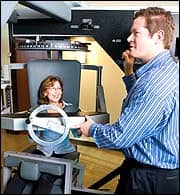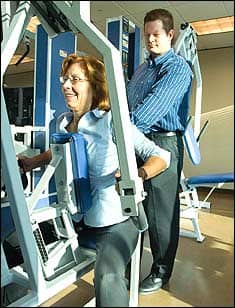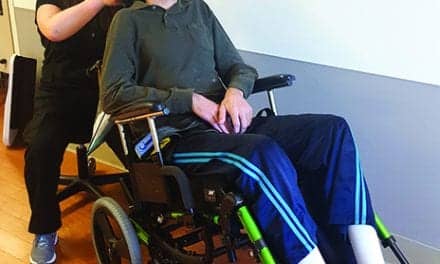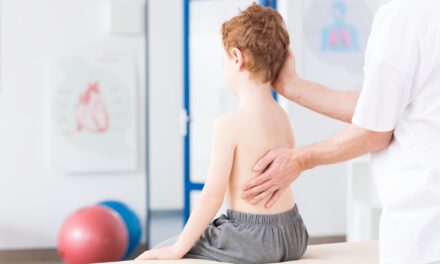 |
| Greg Bradley-Popovich, DPT, MSEP, MS, CSC, oversees patient Barbara Dieringer’s use of core strengthening equipment. |
When it comes to the back, anything and everything can be a culprit in causing pain and injury. From subtle, nagging aches over an extended period of time to a traumatic, possibly life-altering event, injuries to the back can happen at any time or in any place.
According to Greg Bradley-Popovich, DPT, MSEP, MS, CSC, director of physical therapy at NW Spine Management, Portland, Ore, naming the most common risk factors for back injuries opens up a Pandora’s box for experts as this particular area is one of continuous debate.
He says the most common kind of low back pain comes from cumulative stress rather than from a traumatic event or injury. One of the top risk factors for injury is smoking, which has been correlated with lumbar weakness. Another factor is sedentary occupations.
“Sedentary occupations also may predispose individuals to increased risk of a lumbar event due to elevated disc pressures associated with sitting that can rob the inner vertebral disc of nutrition,” he says.
Other risk factors include occupations requiring heavy lifting, lumbar and cardiopulmonary deconditioning, and misdirected and ill-conceived exercise programs. Surprisingly, obesity is not a cause of low back pain.
“An individual must be very obese before it has predictive value with respect to low back pain,” Bradley-Popovich says. “Obesity doesn’t necessarily cause back pain in most situations, but if you’re carrying around extra poundage and you should suffer a back injury, it’s likely to take you longer to get over it.”
TREATING CHRONIC PAIN
Sports-related injuries are something that NW Spine sees a lot of. Bradley-Popovich says these injuries happen more in the weight room than on the playing field.
“Some research indicates that weight training for football actually increases the odds of having low back problems,” he says. “We probably see more youths who are injured in the weight room than actually on the field.”
The problem is not that athletes are weight training, it is that they are improperly weight training. In doing so, more youths are coming in with injuries ranging from a herniated disc to a spinal fracture. To try to combat this growing problem, Bradley-Popovich and colleague Christopher Mohr recently published a book entitled Weapons for Mass Construction. One highlight of the book is a chapter dedicated to implementing a safe core-conditioning program, including references to studies done on the impact improper training regimens can have on injuries in young people.
“I sincerely believe it’s a good resource for young people to avoid injury and do strength training safely,” he says.
NW Spine focuses on patients with chronic low back pain.
“Several studies have shown that it’s quite difficult to improve upon low back complaints during the first few weeks after an event,” he says. “We specialize in that 10% or so of patients who have not shown spontaneous improvement after 6 weeks or so.”
The clinic uses a two-prong approach to treating those patients: MedX and McKenzie. Using MedX, a patient with chronic pain may be subjected to spinal performance testing to assess range of motion, strength, and endurance. McKenzie, on the other hand, is more specific in application, resulting in a prescription of just one or two exercise techniques.
“Since fear has been shown to be a stronger predictor of disability than even pain, better spinal function and a successful experience of exercise without injury should diminish fears while discouraging diseases associated with a hypokinetic lifestyle,” he says. “As I explain to my patients, would you rather have a back that’s painful and weak or a back that’s painful and strong?
“In my view, virtually 95% of patients will succeed to some degree with the program in terms of improving function, and unfortunately, 15% do not achieve pain alleviation concurrent with their improvement in function. So I tell all my patients, ‘I feel pretty confident that you’re going to have some success. Only in retrospect can we assess how successful you can be.’ “
Both the MedX and McKenzie methods emphasize exercise and patient empowerment. A typical program runs 8 to 12 weeks with twice-weekly visits, and these patients are encouraged to remain active, he says.
“In my view, a gym program is preferable to an exclusively home-based program because it allows for a greater variety of training resources as well as quantifiable exercise, which is important for measuring progressive overload and progress,” he says.
HOW EXERCISE RELEASES SPINE PAIN
Some of the most common chronic conditions NW Spine sees include degenerative disc disease, herniated and extruded discs, degenerative joint disease, spondylolysis, spondylolisthesis, and sprain/strain.
In coming up with a methodology for treating chronic conditions, Bradley-Popovich expands on some points he cites from Stanley Paris, PhD, PT.
First, repetitive motion gates pain. It also relaxes muscle spasm, lubricates joints, favorably alters the chemical balance in inner vertebral discs, and enables a patient to conquer a fear of movement.
“Spinal exercise increases blood flow to the spine, thus providing improved nutrition to joints, discs, bone, and muscle,” he says. “General exercise may reduce body weight, thus reducing stress on the spine that may complicate spinal complaints. Progressive resistive exercise increases the thickness of muscle, ligament, tendon, and bone, thus decreasing the chance of mechanical overload due to improved issue integrity.”
TREATING CHRONIC DISORDERS
For patients with a chronic disorder, such as scoliosis or fibromyalgia, Bradley-Popovich says the underlying principles for the treatment involved are the same, although the methods are slightly different. Patients with fibromyalgia generally require slower progression of overload, a slower pace, and a stronger emotional support strategy, he says. On a 10-point scale, effort is usually limited to a perceived exertion of 6.
TREATING SCOLIOSIS
Scoliosis is a subspecialty of NW Spine, and is an active research area for the clinic. He says adolescents with scoliosis do not typically complain of pain as they are more concerned with the aesthetics of their curvature. Parental education plays a large role in treating adolescents since it is the parents transporting them to and from the clinic.
 |
| Greg Bradley-Popovich, DPT, MSEP, MS, CSC, supervises Barbara Dieringer’s back-strengthening regimen. |
“The crux of the scoliosis program is testing and exercise on the MedX rotary torso, as was used in Dr Vert Mooney’s publications on exercise for the treatment of idiopathic adolescent scoliosis,” he says. “According to Dr Mooney’s papers, and mirrored in my experience, a majority of scoliotic adolescents have significant strength imbalances in the truncal rotation. The progress of the scoliotic adolescent undulates less than that of the chronic pain patient since there is not the confounding variable of pain.”
Adults with scoliosis are treated the same way as adolescents, but more frequently with additional pain management.
“Preliminary research shows that strength asymmetry is less predictable than in youth, supporting the need for testing,” he says. “The majority of these patients do achieve meaningful pain relief and curve stability.”
He says that 80% to 90% of patients with unstable scoliosis are females of pubescent and menopausal age, leading him to speculate that there may be a hormonally mediated neuromuscular factor in the ideology of scoliosis.
TAKING A CONSERVATIVE APPROACH
“Medical research reveals that patients informed that they required back or neck surgery have a 92% chance of avoiding surgery with aggressive physical therapy using modern technology.”
This quote on the home page of NW Spine’s Web site (www.ccc.com) was taken from a study conducted by Brian Nelson, MD, an orthopedic surgeon who operates similar clinics in the Minneapolis/St Paul area. For a clinic that emphasizes exercise, Bradley-Popovich says this number represents a large number of individuals who can be helped through conservative methods, like physical therapy.
“I’m not antisurgery, I’m just proconservative,” he says. “And once you’ve exhausted your conservative options within a reasonable span of time, then surgery may make sense. But it’s important to realize that the success rate with surgery is not 100%, and we see surgical failures on a daily basis here.”
He says the physical therapy industry is getting bolder in patient education so patients know there is an alternative to surgery.
“Many patients view orthopedic surgeons and neurosurgeons as the specialists in spine care, but I think that there is ample room for the expertise of conservative practitioners. After all, isn’t it quite skillful and artful to fix a person’s complaints without so much as an incision?”
Bradley-Popovich says patients should not be asking if surgery can help, but if surgery is required. Most often, he says, that answer is “No.”
“Once patients realize the limitations of both conservative and surgical interventions, and their fears are calmed, they are further empowered to negotiate the path of health care intervention strategies without the emotional sense of urgency and the catastrophic thinking that erroneously accompany spinal complaints,” he says.
Other alternatives to surgery include other styles of physical therapy, chiropractic, and acupuncture.
“Another good adjunct treatment to physical therapy or to active-based physical therapy is epidural and facet injections,” he says. “Alone, I don’t think that those treatments offer long-term benefits, but when used to facilitate a restoration of function, I think they can make a significant impact for patients who have an underlying inflammatory issue.”
In working with patients to avoid back surgery, Bradley-Popovich says exercise equipment in the form of cardiopulmonary, flexibility, and strengthening equipment is the foremost and most potent modality. He says NW Spine tries to avoid passive modalities such as ultrasound and electrical stimulation, using them only for patients who might have a low tolerance for pain.
“Our bias is exercise, so in terms of any modality we really view that as the way to go,” he says.
Additionally, the clinic has two licensed massage therapists on staff for individuals who have pain of muscular origin.
Morgan Saffari is a contributing writer for Rehab Management. For more information, contact





